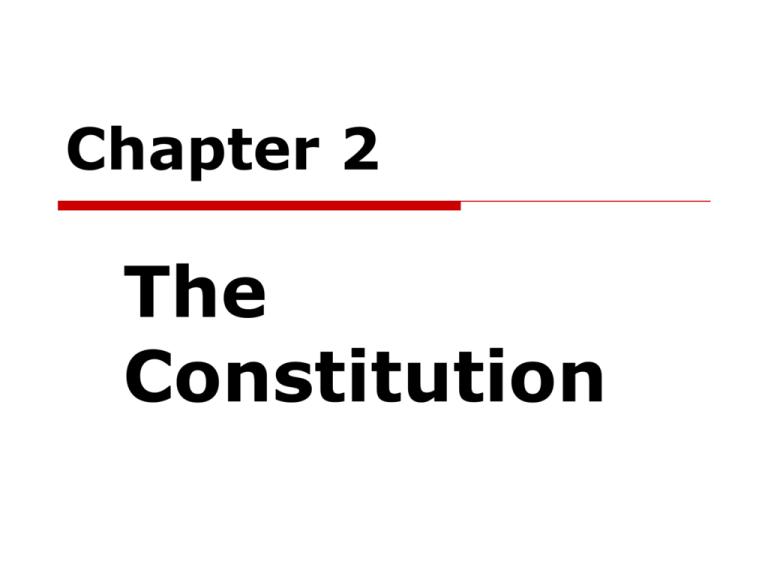Bill of Rights (1791)
advertisement

Chapter 2 The Constitution Impact of Colonial Experience Jamestown – first permanent English colony (1607); set precedent for a representative assembly Plymouth – Mayflower Compact (1620) set precedent for social contract based on the consent of the governed; adult males agreed to create and submit to authority of government Selected Milestones in the Colonial/Early American Era Stamp Act (1765) First Continental Congress (1774) Second Continental Congress (1775) Revolutionary War (1775-1781) Declaration of Independence (1776) Articles of Confederation drafted (1777) Shays’ Rebellion (1786) Constitutional Convention (1787) U.S. Constitution (1788) Bill of Rights (1791) Reading Exercise Consult the Declaration of Independence (pages 371-372) What does Jefferson mean by unalienable Rights? What are they? What is the purpose of government? What is the basis of government’s legitimacy/authority? Under what conditions is Revolution justifiable according to Jefferson? Key Ideas in the Declaration of Independence Natural Rights – individuals hold certain rights because they are human; governments cannot take away these “unalienable” (inalienable, can’t be transferred) rights; they are given to us by God Locke describes these rights as “life, liberty, and property” Jefferson describes these rights as “Life, Liberty, and the Pursuit of Happiness” Social contract – general agreement between the people and the government; people agree to give up some of their liberties so that the remainder are protected Popular sovereignty/government by consent – all legitimate authority flows from consent of people Right/Duty to revolt (Revolution) Adopted by 2nd Continental Congress (July 4, 1776) Discussion Question Why did Jefferson write, “…pursuit of happiness” rather than “property”? Let’s assume he wasn’t trying to cover up plagiarism; Locke was widely read at the time, at least among the elite What has been the effect of this phrase, “pursuit of happiness” on American politics? Articles of Confederation Drafted by 2nd Continental Congress (1777) Article II guaranteed each state would retain sovereignty Structure of government under Articles Power flowed from the states to the Congress of the Confederation Shays’ Rebellion (1786), although suppressed, illustrated the Confederation’s weaknesses, its inability to maintain order and provide security Table 2-1: Powers of the Congress of the Confederation, 26 CONGRESS HAD POWER TO: CONGRESS LACKED POWER TO: Declare war and make peace Enter into treaties and alliances Establish and control armed forces Requisition men and money from states Regulate coinage Borrow money and issue bills of credit Fix uniform standards of weight and measurement Create admiralty courts Create a postal system Regulate Indian affairs Guarantee citizens of each state the rights and privileges of citizens in the several states when in another state Adjudicate disputes between states on state petition Provide for effective treaty-making power and control foreign relations; it could not compel states to respect treaties Compel states to meet military quotas; it could not draft soldiers Regulate interstate and foreign commerce; it left each state free to set up its own tariff system Collect taxes directly from the people; it had to rely on states to collect and forward taxes Compel states to pay their share of government costs Provide and maintain a sound monetary system or issue paper money; this was left up to the states, and monies in circulation differed tremendously in value Constitutional Convention (1787) Initially aimed at revising the Articles, but became much more… 55 delegates Secret proceedings Monarchist nationalists Democratic nationalists Delegates opposed to any national government Compromises in Drafting the Constitution Great Compromise – resulted in a bicameral legislature, with one house based on equal representation (Senate), the other on population (House) Three-Fifths Compromise – resulted in slaves being counted as “3/5” of a person for the purpose of determining population for representation in the House of Representatives Discussion Were the Great and 3/5’s Compromises necessary and appropriate? Congress outlawed the slave trade in 1808 (importation of slaves, not slavery; Article 1, Section 9) What might have happened if the Constitution had not been ratified? Constitution’s Key Characteristics Popular Sovereignty Refer to Preamble, page 373 Republican/Representative democracy Limited government Separation of Powers and Checks and Balances Dividing governmental powers between legislature (makes laws), judicial (interprets laws), and executive (administers laws) Providing checks on abuse of power Federalism Separation of Powers Branch: Executive Presidency Judicial Federal Courts Senate President Judges Electoral College, whose members are chosen by the people (originally, by state legislature) President, with advice and consent of Senate 4 years Life All people Constitution Legislative Congress House Officials chosen by: People People (originally, state legislatures) For term of: 2 years 6 years To represent primarily: Common people Large states Wealthy people Small states Ratification Federalists argued in favor of ratification; supported strong central government Federalist Papers, Appendix C, pp. 391396 No. 10: argument for representative democracy vs. direct democracy No. 51: Separation of Powers, Checks and Balances, and Federalism Anti-Federalists opposed strong central government Helped by promise of amendments protecting individual rights – Bill of Rights (1791) The Bill of Rights (1791) First 10 amendments to the Constitution Designed to protect individuals from a too powerful national government Limited federal encroachments but not state violations until 14th amendment Figure 2-2: Formal Constitutional Amending Procedure, 37 Why Such a Difficult Amendment Process? Two-step process: Proposal and Ratification > 11,000 amendments considered by Congress 33 submitted to states; only 27 ratified Fear of tyranny of the majority Oppression of groups or individuals Modes of Constitutional Change Formal amendment process Congressional legislation Presidential actions Judicial review Interpretation, custom, usage Discussion What are the strengths and weaknesses of: separation of powers? checks and balances? a difficult amendment process? Hot Links to Selected Internet Resources: Book’s Companion Site: http://politicalscience.wadsworth.com/schmidtbri ef2004 Wadsworth’s Political Science Site: http://politicalscience.wadsworth.com Emory University, School of Law, Constitution of the United States: http://www.law.emory.edu/erd/docs/usconst.html National Constitution Center: http://www.constitutioncenter.org Web Guide to the Constitution of the United States: http://tcnbp.tripod.com/webguid.htm






